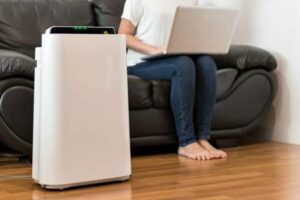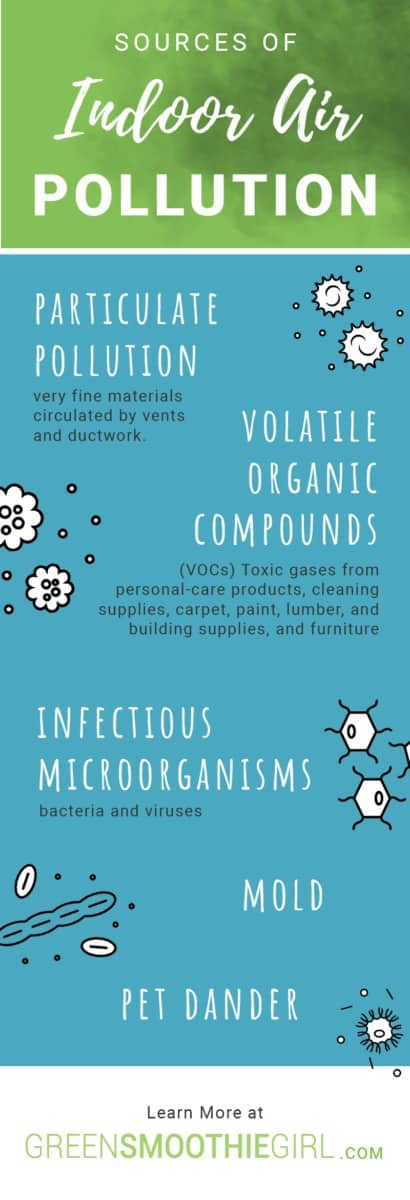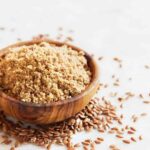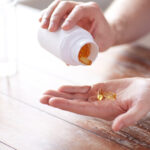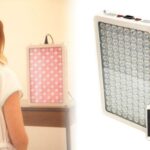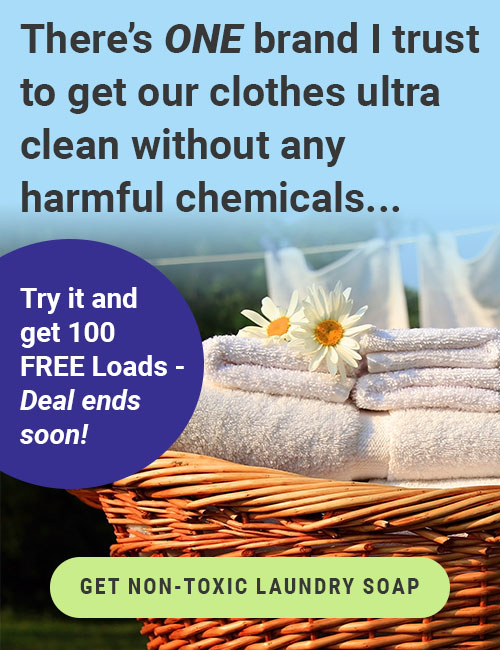Could Your Home Indoor Air Be Polluted? How To Clean It Up
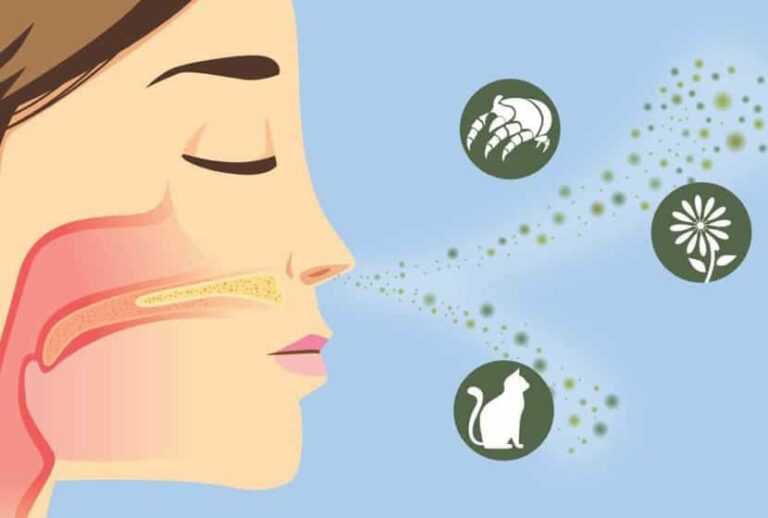
If you live in a city, you might be aware that there’s a lot of junk in the air, when you go outside. But, have you thought about the air you breathe inside your home?
Years ago, I lived on the Wasatch Front of Utah, and when warm air trapped the cold air in the “bowl” of the valley, the air quality could be worse than China’s on some days. On the day I wrote this post, our PM 2.5 (fine particulate pollution) was 850 times the EPA’s upper limit.
In this article:
- Poor Air Quality Increases Disease Risk
- Indoor Air Pollutants
- Why Should You Clean the Air in Your Home?
- Particulate Pollution
- Volatile Organic Compounds (VOC’s)
- Infectious Microorganisms
- Pet Dander
- Molds
- Common Symptoms of Indoor Air Pollution
- Long-Term Health Risks of Indoor Air Pollution
- The Best Indoor Air Pollution Solution I’ve Found
- Enjoy Cleaner Air at Home
- Replace Your Products With Cleaner Versions
Breathe Easier with a Home Air Purifier
Poor Air Quality Increases Disease Risk
The CDC estimates 2,000 of us die, directly of the air quality, every year.
This doesn’t account for how many of us are at higher risk for cancer and other problems, later on, from the exposure.
And of course, people with asthma and other respiratory and pulmonary problems are at very high risk.
The Problem with Indoor Air Pollution
What I didn’t know, until recent years, is that indoor air pollution can be worse. While particulate pollution is higher outside, chemical pollution can be exponentially higher, inside.
Why that’s so, and what I did to clean up virtually 100% of it in my own home, are what I'll tell you about in this post.
What Indoor Air Pollutants Might Be in Your Home?
The reason pollution is so high in our homes isn’t just related to nail polish, hairspray, air fresheners, laundry detergent, and chemical cleaning supplies. Many of us got rid of those things long ago because they contain such toxic ingredients.
- We also have exposure to formaldehyde, heavy metals, and noxious gases from sources that are harder for us to control.
- Consider that carpet is made of petroleum products and sprayed with Stainmaster chemicals, and furniture upholstery is treated similarly.
- Paint contains dozens of toxic chemicals, and it off-gasses for many years.
- A new home is the most toxic place of all, given that all the sprayed chemicals are at their highest offgassing point. (Only very old homes will have lead paint, etc.)
How to Clean the Air in Your Home
I will briefly review the types of toxins in your home, and what filtration system I chose, and why. I won’t go into great depth about each type of pollutant, because the solution is very important.
There is a solution, it’s not very expensive, and it’s important that anyone living in a modern building do what they can, to protect their health.
Why Should You Clean the Air in Your Homes?
What if some of the unexplained symptoms you may be having are related to unseen pollutants in your indoor environment?
Increasing Deaths Due to Air Pollution
The World Health Organization (WHO) has estimated that 7 million people a year die, worldwide, of environmental pollution, and 4.3 million of them are from primarily indoor pollutants.
WHO called air pollution “the world’s largest single environmental health risk” (March 25, 2014). We may have up to 500 times more pollution inside, than outside!
Cleaning Indoor Air Pollution Is Possible
Luckily, there’s much more we can do about our indoor air pollution, than what we’re able to control our outdoor air pollution, as well.
And since most of us spend over 90% of our time inside, it’s critically important to address the issues.
Particulate Pollution
Some of what’s outside gets inside. Besides your doors, think of your vents, and ductwork.
Your heater and air conditioner create their own byproducts, but they also recirculate very fine material, called particulates, that gets in the smallest airways of your lungs, and doesn’t come out easily. This puts you at risk for many lung problems, from asthma to lung cancer.
Some particulate is under 10 microns in diameter, PM 10, and some are much smaller (and more dangerous), such as PM 2.5. Each category has been linked by research to specific respiratory, pulmonary, and cardiovascular problems.
Volatile Organic Compounds (VOC’s)
- Toxic gases, including formaldehyde, carbon, chlorine, fluorine, toxic forms of ozone, and nitrogen oxides
- Chemicals off-gas from personal-care products, cleaning supplies, carpet, paint, lumber and building supplies, and furniture
- Industrial plants and car emissions
- Candles
And the vast majority of indoor air filters do nothing to eliminate these chemical pollutants, even if they do a reasonable job of cleaning up particulates.
Viruses and Bacteria
Bacterial and viral organisms thrive in wet washcloths and damp environments in the home. A recent trend is to treat the problem with antibacterial soaps, gels, wipes, and other products.
Why You Should Avoid Antibacterial Products
The personal-care industry is making a fortune on these products. But, the problem with this approach, from the standpoint of your health, is similar to the effects of our taking antibiotics:
Yes, it wipes out the “bad” bacteria in that spot (for instance, your counter, or your hands), but antibacterial gels and soaps also kill the entire “microbiome,” including all the “good” bacteria, on your skin. Which you need, for healthy skin, and—ironically—for keeping the bad bacteria you’ll pick up, a few minutes later from another source, in check.
(You can kill the bacteria in a small area, with one of those products, but guess what: they’re everywhere. In the air, and on dozens of other surfaces in the room. In the end, we can’t live in a bubble, and we can’t spray or gel or wash every corner of the Universe.)
The Problem with Pet Dander
As my children grow up and leave home, my kitty is my best friend. I’d never give her up, because while she may have dander that isn’t particularly conducive to human health, she’s my buddy while I sit at my computer, researching and writing every day.
Having a Pet at Home
Contact with a furry pet is healing and raises our vibration in so many ways, especially for people who live alone.
But I’m slightly allergic to cats, and so is my 17-year-old son. We had no cats for 20 years, while my oldest son lived here, as he was severely allergic.
Beta Glucan for Cat Allergies
Tennyson and I take beta glucan, which scientists have published many studies about its effect on strengthening the immune system.
For us, the effect has been that we are able to tolerate cats, now, with no symptoms.
Dander Weakens the Immune System
Although some people have allergies to cats, and sometimes dogs—all of us are at least mildly reactive to danders. Even if you don’t itch and sneeze, around cats, their dander provokes an immune response, which puts your immune system in “fight” mode, making it weaker against a cold or flu, or more serious illness, when it comes along.
Purifying the air from danders is another reason to consider a great filtering system that eliminates this, as well as particulate and infectious organisms.
Molds
Awareness is increasing that some forms of mold in a home—even from a water leak that soaked drywall or carpet many years ago—has made legions of children and adults sick.
That illness doesn’t always disappear after the family rebuilds the problem wall or ceiling or floor—or even moves away.
Molds in the Human Body
That’s because those mold spores take up residence in the human respiratory system, organs and tissues, and can take years of treatment and clean eating, to recover from.
Most of us think of “black mold” as being the killer, but virtually all molds cause an immune response, weakening the entire immune system, over time.
What Are Some Common Symptoms of Indoor Air Pollution?
If you have any of the following symptoms, the culprit may be particulate or chemical pollution inside your home:
- Sneezing
- Wheezing
- Itchy throat or nose
- Itchy or watering eyes
- Nasal congestion
- Coughing
- Itchy skin
- Hives/rash
- Fatigue
- Irritability
- Runny nose
- Stomachache / Nausea
Long-Term Health Risks of Indoor Air Pollution
Long term, if you are exposed to many of these pollutants, documented health risks include:
- Respiratory infections
- Heart disease
- Pulmonary disease (COPD)
- Cancer
- Cardiovascular disease
- Asthma
The Best Indoor Air Pollution Solution I’ve Found
Over the years, a few times, I researched the options to clean up the air in my home (where I also work)—but was frustrated that the solutions were (a) noisy, (b) cleaned up some, but not nearly all, of the particulate, and (c) cleaned up the particulate, but not the chemical pollution.
Use a Home Air Purifier
After years of looking, I discovered a solution that eliminates not only 100 percent of the particulate, even as small as below PM .3, but also virtually all (over 99.96%) of the chemical toxins as well.
I was shocked that a quiet, portable unit I could put in the corner of a room would change the air up to four times every hour—adjusting to light, moderate, or heavy pollution. (My unit actually shows me how bad the air currently is in my home.)
I asked the company if I could have a discount to help protect my community.
You can get that discount now, for any number of units—even just one. If you get just one unit, put it in the part of your home you spend the most time in!
The Best Home Air Purifier I’ve Found
Both of the times I studied the technology and eventually abandoned my search because the options just weren’t good enough or they were terribly expensive. This new option isn’t pricey, and it works. AirDoctor was able to prove to me that this technology is about 100 times more effective than other solutions on the market.
I have to replace my inexpensive replacement filter about every 6 months, though in less polluted areas, you may be able to use yours for up to 12 months.
Portable Indoor Air Purifier
Now my family and I can “breathe easier,” both literally and figuratively.
I love that when I moved to the higher elevations in Park City, Utah—out of the inversion, finally, when my youngest headed off to college!—I was able to take these portable units with me.
It's Worth the Investment to Enjoy Clean Air at Home
My hope is that this helps you, on your road to health. So many folks I talk with, on my many lecture tours over the years, have unexplained symptoms that doctors haven’t been able to diagnose.
And it’s a very rare doctor educated about environmental toxins, who will help you, in your super-sleuthing of “what’s making me sick.”
We can’t live in a non-toxic world, especially those of us living in urban areas, thanks to 80,000 chemicals approved by our government for use in our environment. But we can, and should, protect our families from as much of it as we can.
Replace Your Products With Cleaner Versions
Be sure to buy nail polish free from the biggest toxins, if you paint your nails. It’s not exactly “non-toxic,” but it eliminates the 10 worst offenders, in most common nail-polish brands. Paint your nails outdoors, not indoors (and leave it off, in the winter when your feet are covered).
1. Gel Nail Polish
Don’t use the “gel toes” in the salon. There’s a reason your nail technician covers her mouth and nose with a mask! To get it off, many nail technicians ask you to dip your toes in acetone, which is terribly toxic and is absorbed through the many large pores in your feet, right into your bloodstream.
2. Hair Spray
Stop using hairspray, if possible, and replace your hair products and other personal-care items with non-toxic versions found in natural-products stores.
List of Chemical Ingredients
We’ve made you a wallet card, to take to the store with you, to compare ingredients against anything you buy. The wallet card is free, and it identifies the chemicals linked in research to serious health risks.
3. Aerosol Cleaning Products
I have the same advice for cleaning products. The worst are the ones you spray in your shower to get rid of limescale. (Remember, that’s an enclosed space, and the steam in your shower makes your skin that much more permeable to those noxious gases.)
You can get non-toxic cleaning products, as well, from a natural products store. More brands are becoming eco-friendly and far better for you.
4. Metal Wicks and Toxic Candle Wax
If you burn candles, buy them with non-metal wicks and no-toxins wax products. For a bigger spend, you can paint your home with less-toxic paint, and even buy non-toxic furniture.
With these tips and a small but important investment in a portable air filtration unit in your home, I hope you’re breathing easier, soon!
How do you clean the air pollution in your home? Share them with us in the comments section below!
Up Next: VIBE Episode 64: Indoor Air Pollution with Peter Spiegel

Disclosure: This post may contain affiliate links that help support the GSG mission without costing you extra. I recommend only companies and products that I use myself.
Posted in: Detox, Health Concerns, Lifestyle, Tools & Products



